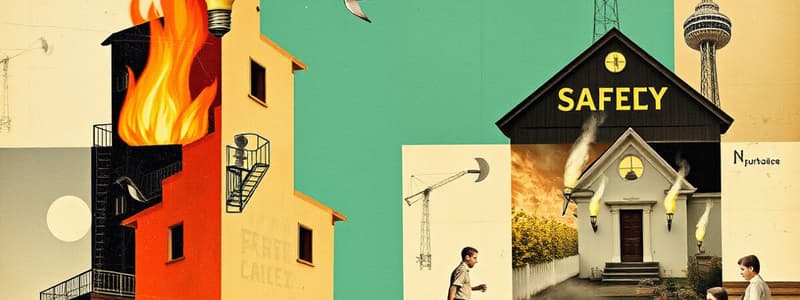Podcast
Questions and Answers
What are the primary reasons for performing ventilation in a fire situation?
What are the primary reasons for performing ventilation in a fire situation?
- To regulate temperature and disperse chemicals.
- To control smoke and improve insulation.
- To allow attack teams to enter and operate, and to provide fresh air for trapped occupants. (correct)
- To prevent structural damage and aid in firefighting strategy.
What is one common misconception about the need for ventilation?
What is one common misconception about the need for ventilation?
- It is only necessary during large-scale fires.
- Ventilation is primarily for improving visibility, not for allowing entry.
- Firefighters can operate effectively without any ventilation.
- SCBA eliminates the need for ventilation entirely. (correct)
What is a major decision involved in the process of ventilation during a structure fire?
What is a major decision involved in the process of ventilation during a structure fire?
- Determining the fire's water source
- Deciding on the evacuation route for civilians
- Calculating the fire's burn rate
- Decisions on timing, as well as location of ventilation and flow paths (correct)
When is it recommended to manipulate locking devices on a window for ventilation?
When is it recommended to manipulate locking devices on a window for ventilation?
What should the extent of damage from fire extinguishment and ventilation efforts reflect?
What should the extent of damage from fire extinguishment and ventilation efforts reflect?
Which statement best describes 'textbook ventilation'?
Which statement best describes 'textbook ventilation'?
Which factor contributes to a faster spread of fires in modern buildings?
Which factor contributes to a faster spread of fires in modern buildings?
Why is it crucial for the area of refuge to be on the same side of the hall as the fire apartment?
Why is it crucial for the area of refuge to be on the same side of the hall as the fire apartment?
What role does the wind load play in fire safety management?
What role does the wind load play in fire safety management?
In the context of fire emergencies, what is a significant benefit of having the area of refuge on the high-pressure side?
In the context of fire emergencies, what is a significant benefit of having the area of refuge on the high-pressure side?
What is typically the most cost-effective method of venting for peaked roofs?
What is typically the most cost-effective method of venting for peaked roofs?
Generally, horizontal ventilation for a life hazard must be coupled with an immediate ____ effort
Generally, horizontal ventilation for a life hazard must be coupled with an immediate ____ effort
Very dense smoke conditions together with a strong potential for locating a victim justifies breaking glass even in the absence of ____
Very dense smoke conditions together with a strong potential for locating a victim justifies breaking glass even in the absence of ____
If the fire is in a fire resistive building it may be desirable to ____ venting until after the hose stream has thoroughly cooled the fire area
If the fire is in a fire resistive building it may be desirable to ____ venting until after the hose stream has thoroughly cooled the fire area
The real trick is to remain in buildings long enough to _____ all of the necessary task
The real trick is to remain in buildings long enough to _____ all of the necessary task
Serious fires that threaten the very existence of a structure demand _____ ventilation in order for interior forces to do their job
Serious fires that threaten the very existence of a structure demand _____ ventilation in order for interior forces to do their job
The key factor between venting for life or venting for fire is the _____ of the ventilation
The key factor between venting for life or venting for fire is the _____ of the ventilation
Venting for fire is normally ____ until resources are in place to attack. Some cases venting may be withheld until the attack has knocked down the fire
Venting for fire is normally ____ until resources are in place to attack. Some cases venting may be withheld until the attack has knocked down the fire
Pg 233 says that the FFs should not vent windows from the outside when FFs are inside unless permission is given from the IC or the _____ within the fire area
Pg 233 says that the FFs should not vent windows from the outside when FFs are inside unless permission is given from the IC or the _____ within the fire area
At time ventilation preformed ____ from the fire room is what triggers the sudden in rush of air through the building. The air flow needs an exhaust opening to reach its maximum intensity
At time ventilation preformed ____ from the fire room is what triggers the sudden in rush of air through the building. The air flow needs an exhaust opening to reach its maximum intensity
Horizontal ventilation for a ____ hazard must be coupled with an immediate reduce effort. Either members must remove the victim or place a hose to protect the victim
Horizontal ventilation for a ____ hazard must be coupled with an immediate reduce effort. Either members must remove the victim or place a hose to protect the victim
_____ venting is the most suitable type of ventilation for most fires in houses and similar size structures
_____ venting is the most suitable type of ventilation for most fires in houses and similar size structures
Very dense smoke conditions together with a strong potential for locating a victim( such as when operating in a ____ house late at night) justifies breaking glass, even in the absence of heat
Very dense smoke conditions together with a strong potential for locating a victim( such as when operating in a ____ house late at night) justifies breaking glass, even in the absence of heat
Generally, Venting for fire should take place just after the _____ begins its attack. This is best coordinated via ____. A member of the ____ team should give the word to take the windows shortly after the nozzle team gets water on the fire
Generally, Venting for fire should take place just after the _____ begins its attack. This is best coordinated via ____. A member of the ____ team should give the word to take the windows shortly after the nozzle team gets water on the fire
In the case of tightly sealed areas, typically glazed with double or ____ pane energy efficient windows, you must recognize the potential for difficulties when ventilation is begun while FFs are in proximity to the fire room
In the case of tightly sealed areas, typically glazed with double or ____ pane energy efficient windows, you must recognize the potential for difficulties when ventilation is begun while FFs are in proximity to the fire room
In ______ buildings, like a high rise multiple dwelling, it may be desirable to delay venting until after the hose stream has thoroughly cooled the fire area
In ______ buildings, like a high rise multiple dwelling, it may be desirable to delay venting until after the hose stream has thoroughly cooled the fire area
The other alternative in fire resistive buildings is to undertake window venting as soon as possible while the ____ team is in a safe area, preferably behind a closed door
The other alternative in fire resistive buildings is to undertake window venting as soon as possible while the ____ team is in a safe area, preferably behind a closed door
_____ ventilation is often the deciding factor in wether the fire is stopped in its tracks or continues to expand
_____ ventilation is often the deciding factor in wether the fire is stopped in its tracks or continues to expand
When distinguishing between venting for fire or venting for life, the key factor is the ____ of the ventilation. Venting for life should obviously begin as soon as possible after the life hazard has been recognized
When distinguishing between venting for fire or venting for life, the key factor is the ____ of the ventilation. Venting for life should obviously begin as soon as possible after the life hazard has been recognized
Depending on _____ arrangements, size and proximity of the fire, wind direction and ____ and other factors the fire may be drawn to the open window
Depending on _____ arrangements, size and proximity of the fire, wind direction and ____ and other factors the fire may be drawn to the open window
Flashcards
Tight-building syndrome
Tight-building syndrome
Reduced staffing and energy conservation measures affecting fire safety.
Property conservation
Property conservation
Increased awareness affecting fire management strategies.
Smoke control fans
Smoke control fans
Improved fans enhance smoke control in fires.
Faster flashovers
Faster flashovers
Signup and view all the flashcards
Lightweight building materials
Lightweight building materials
Signup and view all the flashcards
Large open floor plans
Large open floor plans
Signup and view all the flashcards
Green building designs
Green building designs
Signup and view all the flashcards
Life-saving search
Life-saving search
Signup and view all the flashcards
Structure opening
Structure opening
Signup and view all the flashcards
Salvage operations
Salvage operations
Signup and view all the flashcards
Fire suppression
Fire suppression
Signup and view all the flashcards
Ventilation timing
Ventilation timing
Signup and view all the flashcards
Ventilation flow paths
Ventilation flow paths
Signup and view all the flashcards
Venting for fire
Venting for fire
Signup and view all the flashcards
Venting for life
Venting for life
Signup and view all the flashcards
Immediate ventilation
Immediate ventilation
Signup and view all the flashcards
Horizontal ventilation
Horizontal ventilation
Signup and view all the flashcards
Rescue operations
Rescue operations
Signup and view all the flashcards
Extinguishing damage vs. fire damage
Extinguishing damage vs. fire damage
Signup and view all the flashcards
Vertical Ventilation
Vertical Ventilation
Signup and view all the flashcards
Horizontal vs. Vertical ventilation costs
Horizontal vs. Vertical ventilation costs
Signup and view all the flashcards
Roof types and ventilation
Roof types and ventilation
Signup and view all the flashcards
Window ventilation
Window ventilation
Signup and view all the flashcards
Smoke descent
Smoke descent
Signup and view all the flashcards
Breaking vs. opening windows
Breaking vs. opening windows
Signup and view all the flashcards
Study Notes
Fire Safety Improvements
- Recent fire safety changes include reduced staffing and energy conservation measures, leading to "tight-building syndrome."
- Increased property conservation awareness affects fire management strategies.
- Use of improved fans enhances smoke control during incidents.
- Heavier fuel loads, particularly from plastic, result in faster flashovers and increased toxic smoke.
- Lightweight building materials are common but prone to early failure in fires.
- Larger open floor plans facilitate rapid fire spread within structures.
- "Green building" designs can complicate effective fire suppression tactics, such as roof cutting.
Key Firefighter Tasks
- Search for life and active fire.
- Open up structures to expose hidden fires in void spaces.
- Conduct salvage operations to minimize damage.
- Implement effective fire suppression techniques.
Ventilation Considerations
- Key decisions include timing, location of ventilation, and establishing flow paths for fresh air and smoke.
- Two main ventilation purposes:
- Venting for fire: allows attack teams to enter and combat the fire.
- Venting for life: provides fresh air to trapped occupants and improves visibility.
- Proper timing of ventilation is critical; venting for life should commence immediately upon recognizing a life hazard.
Ventilation Techniques
- Know when to break a window versus opening it from the inside, guided by heat rather than smoke conditions.
- If the smoke is descending and manageable, it indicates a safe approach for rescue efforts.
- Horizontal ventilation should coincide with immediate rescue operations to prevent trapping victims with heat and smoke.
Control Measures
- Damage from extinguishment and ventilation should be balanced with fire damage and life hazard extent.
- Horizontal ventilation tends to be less expensive to repair than vertical, especially if already-existing roof openings are present.
- Venting techniques vary based on roof types; peaked roofs may benefit from window ventilation rather than cutting through the roof.
- Vertical ventilation remains critical, but its application should correspond with specific scenarios and structural characteristics.
Studying That Suits You
Use AI to generate personalized quizzes and flashcards to suit your learning preferences.



